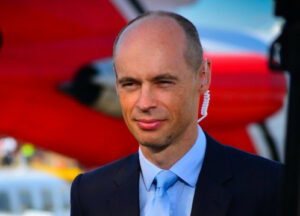By Viktoria Urban

Our Space Café WebTalk “33 minutes with Graham Turnock – The Accelerators: ESA’s plans to warp drive European Space” took place on Tuesday, 28th June.
Graham Turnock has been a Special Advisor to the European Space Agency (ESA) since 2021. Before that, he was Chief Executive of the UK Space Agency.
He has almost 30 years of experience working in Government and international organisations including in a number of posts in the UK Senior Civil Service and on secondment to the European Commission and French administration.
He is an experienced board member in both the public and charitable sectors, including currently working as Treasurer of the Youth Hostels Association of England and Wales and in the past as a Non-Executive Director of the Met Office. He holds a PhD in Particle Physics from Cambridge University for his theoretical work at CERN and a diploma in public administration from the École Nationale d’Administration (ENA).
Graham’s journey into space really began when he was very little. He remembers some of the final Apollo missions and he became so excited about space that at the age of nine he wrote a 100-page book about a space detective. Later, the Space Shuttle came along, which was another very exciting period for Graham and he grew to be an active member of his local astronomy society in Leicester, UK. After studying particle physics at university, he turned his attention back to his first love, space.
Graham says ESA’s accelerators, “Space for green future”, “Rapid and resilient crisis response”, and “Protecting space assets” are about trying to make better use of what space has to offer to solve some of the world’s biggest problems like climate change, emergency response, and dealing with space debris.
“We needed to bring space closer to the users… we needed to make the most of the burgeoning private sector, especially in the applications market.”
He thinks that a lot of applications are still institutionally developed and not so easy to engage with. Graham also states that a lot more could be done with space and that there is a need for a wider community of both public and private sector partners engaged with the opportunities that space has to offer.
While ESA is active on all three accelerators, many more people could be doing something about them. The aim is to bring them together, both the public- and the private sector and create communities around the accelerators to encourage a collective vision, setting a certain amount of coordination. ESA hopes to bring in maritime agencies, forestry agencies, environmental agencies as well and get them infused with what space can do for them.
Graham explains that the focus of “Space for green future” is to create green information factories. This means creating space data centers making it really easy to engage with for businesses and civil society. He says that there is a well-defined gap between what users have access to today and what they really need. The green information factories will be “hot houses”, where application development is encouraged, bringing users closer to the data.
“Rapid and resilient crisis response” helps risk first responders with necessary data. ESA is planning to create an operating system for the emergency sector, whereby all the inputs and capabilities are interoperable. Private-sector application developers then can provide applications to crisis responders. ESA wants to build on this and work with the European Commission as well as the Copernicus and Galileo services to produce a federated system over the next five to 10 years.
“Protecting space assets” aims to make sure that spacecraft de-orbit from low Earth orbit at the end of their operational life. The project also involves building defensive capabilities into satellites to reduce the risk of collision, and also making sure that they are physically harder than the tiny bits of debris to withstand unavoidable collisions. Graham also states that technical standards applications are necessary for space traffic management.
To listen to the Space Café WebTalk’s insights, you can watch the full program here:
Viktoria Urban, contributing Editor at SpaceWatch.Global: After graduating as a Journalist from Edinburgh Napier University, I am now doing an Astronomy and Planetary Science degree at The Open University (Scotland) which has enhanced my already existing love and enthusiasm for space. I am also a member of and a volunteer for several societies both in Hungary and in the UK and write online content on space for multiple companies as well. I hope my science communication will encourage many to find a job in the space sector, whatever their background and highlight important issues to ensure a sustainable space environment for future generations.





